Present in United Kingdom
Reportable – see ‘Report a sighting’ below
Scientific name of causal agent – there is no single causal agent
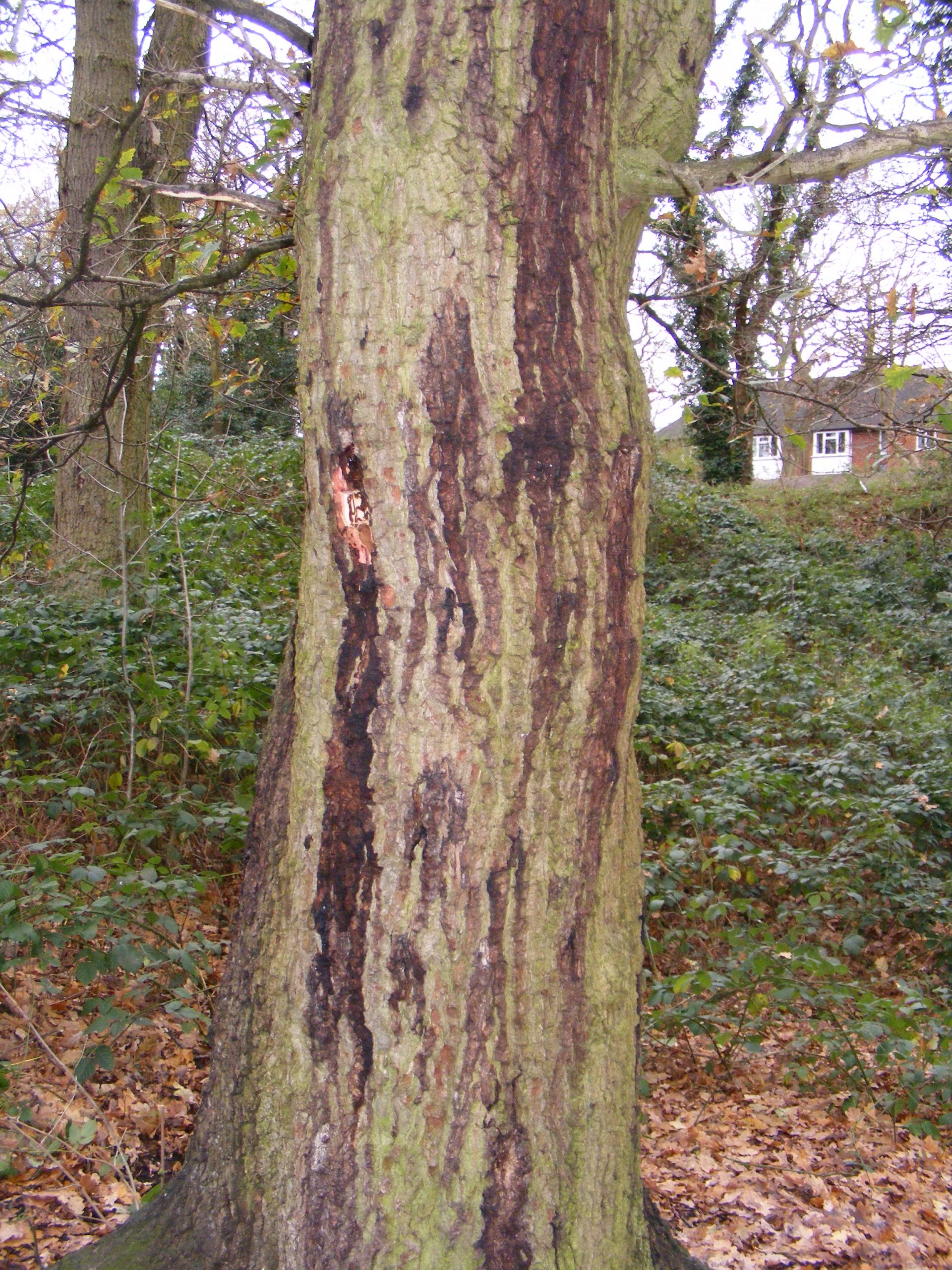
Acute oak decline is an emerging disease of oak trees (trees in the Quercus genus) which was first observed in the UK late in the 20th century. It can kill oak trees within four to six years of the onset of symptoms.
The disease is found mostly on mature oak trees, but younger trees can also be affected. It is caused by multiple agents, especially bacteria, and thousands of trees are affected. For infection to occur, it is likely the trees need to be weakened (predisposed) by certain factors, especially environmental factors.
Distribution
The disease is present in warm, drought-prone parts of the UK where there are also high levels of airborne nitrogen pollution and low dry sulphur levels.
It is found mostly in south-eastern, central and eastern England, and in the Welsh Borders and South-East Wales. As of 2020 it had not been reported in Scotland or Northern Ireland. See our Incidence and distribution page for more-detailed information: it includes a probability map indicating the areas where the disease is most likely to occur based on analysis of the known influential factors.
Holm oak (Q.ilex) and Pyrenean oak (Q. pyrenaica) have been found affected by AOD bacteria in Spain.
Similar decline-diseases of oak have been reported in continental Europe, the Middle East and the Americas. This indicates that AOD is a global concern which might have evaded earlier scientific attention because of the complexity of its causative agents.
Susceptible species
AOD mainly affects the UK’s two native oak species, which are ‘English’ or pedunculate oak (Quercus robur) and sessile oak (Q. petraea). However, cases of other oak species being affected have also been found, including:
- Bali oak (Q. fabri);
- Holm oak (Q. ilex);
- Oriental white oak (Quercus aliena var. acutiserrata);
- Pin oak (Q. palustris);
- Pyrenean oak (Q. pyrenaica);
- Red oak (Q. rubra);
- Scarlet oak (Q. coccinea);
- Turkey oak (Q. cerris); and
- Water oak (Q. nigra).
Most affected trees have been mature specimens more than 50 years old, but some affected younger trees with stem (trunk) diameters of 10–12 cm have been recorded.
The threat
Oak trees play significant roles in our economy, landscape, biodiversity, environment and culture. Oak timber is one of our most valuable woodland products, and hundreds of jobs and businesses depend on it to some extent. Oak trees are ecologically very important, supporting rich woodland biodiversity by providing habitat for more other species than any other tree species in the UK.
The complexity of the cause and the rate at which the number of affected trees has increased therefore gives cause for concern for two of our most important and numerous tree species. It is essential that owners and managers of oak trees are vigilant for the disease, and take steps to minimise its occurrence and spread – See ‘Management and control’ below.
Identification and symptoms
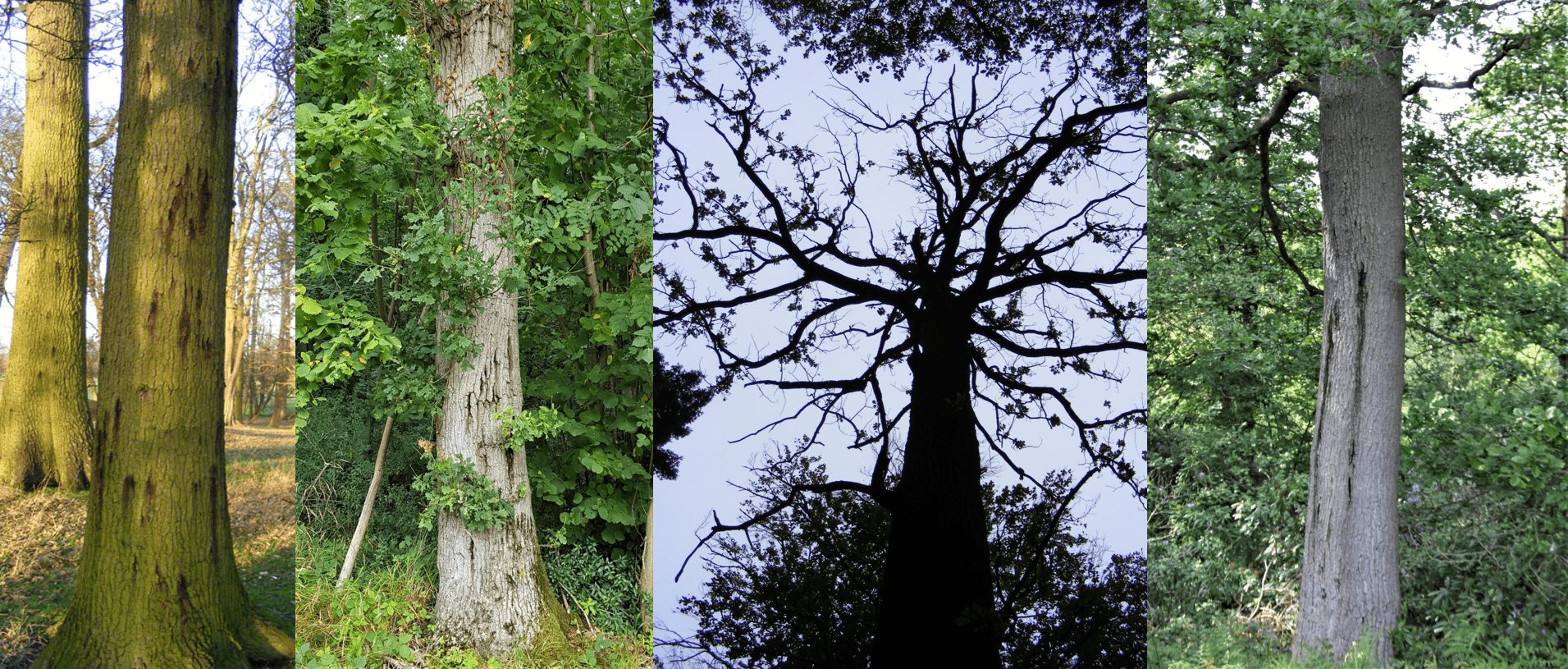
Affected trees have dark-coloured, vertical, weeping fissures, known as stem bleeds or cankers, which seep black fluid through vertical cracks between bark plates and down the trunks, as in the first, second and fourth pictures above. A lesion (decayed tissue) forms in the live tissue beneath the bleeds. The second picture above shows the severe cracks in the bark which the disease can cause at bleed sites.
This seeping fluid can dry and cake on the tree stems at certain times of the year, as shown below.
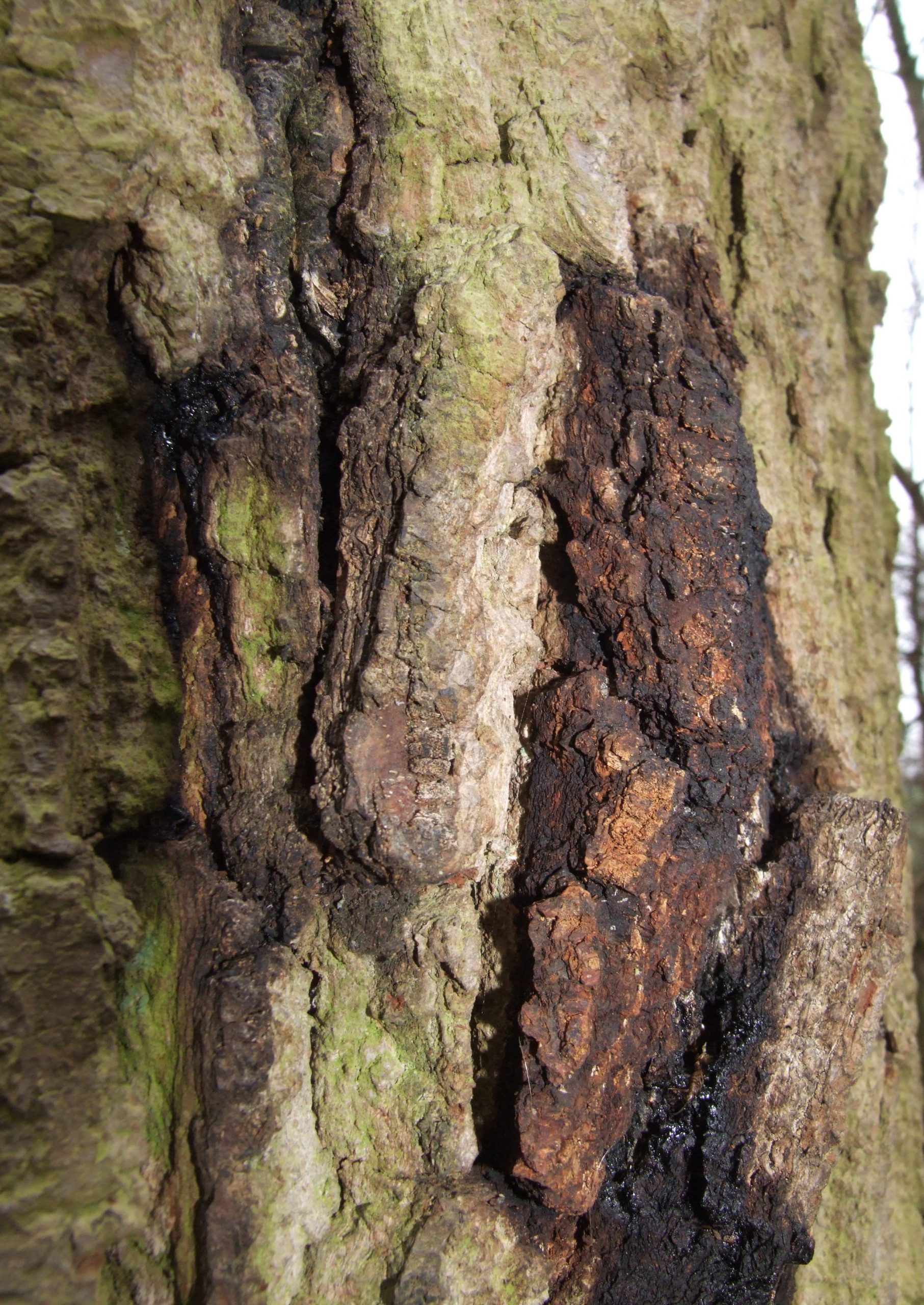
In the early stages affected trees might have one or just a few bleeding points, but their number can increase over time.
Note, however, that weeping patches or stem bleeds are a common response by trees to tissue attack from pests and pathogens, for example Phytophthora species. Therefore a stem bleed alone does not necessarily indicate AOD.
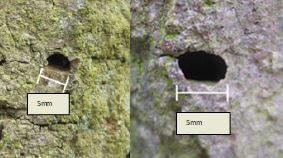
D-shaped exit holes (above left) made by emerging two-spotted oak buprestid beetles (Agrilus biguttatus) might be present in the bark plates of affected trees – about a third of cases show this. These holes are approximately 4 mm wide and 3 mm high. For comparison, the picture on the right shows the more oval-shaped exit hole made in oak bark by an adult long-horn beetle from the Cerambycidae family of species. The scale bar is 5 mm.
Networks of the beetles’ larval galleries are often found in association with, and beneath, the lesions.
The tree canopy is likely to thin, as in the third picture in the montage above, as the tree nears death, and symptoms can develop rapidly over 18 months. The picture below shows a young oak with dieback caused by acute oak decline.
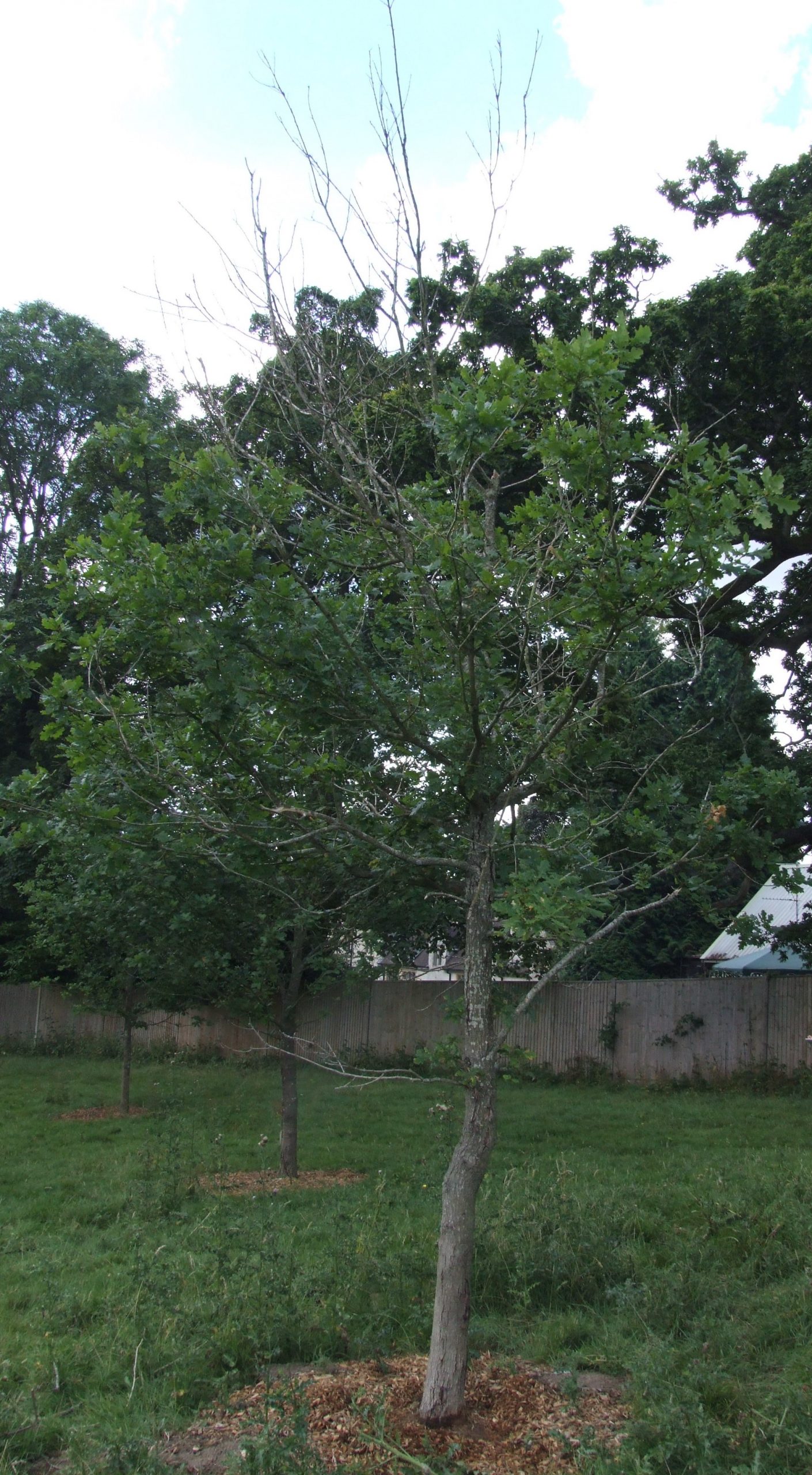
Our further page on symptoms has more-detailed guidance and pictures to help with AOD identification.
Report a sighting
We invite reports of suspected cases of acute oak decline, especially from places where we have not already recorded it. (See the map accessible from ‘Distribution’ above.)
- Report suspected sightings in Great Britain to us using Tree Alert.
- Report suspected sightings in Northern Ireland to the Irish forestry and plant health authorities using TreeCheck, the all-Ireland tree disease reporting tool.
Please note that TreeAlert and TreeCheck both require photographs to be uploaded. These should be clear, well-lit, close-up pictures of symptoms.
If you cannot use TreeAlert, you may report a suspected case to us by telephone or email to our Tree Health Diagnostic & Advisory Service.
If reporting sightings by email or phone, please include:
- a precise location of the tree/s – a 10-digit Ordnance Survey grid reference is ideal, e.g. AB 12345 67890. Otherwise provide a full address, including property name and/or street or road number and the full postcode; and/or
- precise instructions for finding the tree/s, e.g. “40 metres north-west of the entrance to (name) Park in (name) Street”;
- a telephone number where we can reach you during the daytime to clarify any points;
- a clear, well lit photograph with email reports if you can; and
- contact details of the owner or manager of the tree/s, if known.
Disease mechanism
Acute oak decline is a complex disease which manifests itself on the stems of oak trees as patches of black fluid weeping from cracks in the bark, which cover rotting tissue. In severe cases this stem rot can encircle almost the entire girth of the tree, preventing it from moving water and nutrients essential for growth up and down the stem. The trees become weak as a result, and can die within four to six years of the onset of symptoms. This is a rapid rate of decline for trees, which is why the disease is described as acute.
These bleeding lesions, or cankers, are caused by a cocktail of different species of bacteria. Three in particular, Brenneria goodwinii, Gibbsiella quercinecans and Rahnella victoriana, are consistently found in abundance in the lesions. These three bacteria species were unknown until they were discovered and described during our research into acute oak decline.
Also found on a high proportion of affected trees is the native two-spotted oak buprestid beetle (Agrilus biguttatus). Their presence on affected trees is consistent with their preference for declining oak trees as habitat. However, in large numbers – and their numbers have been increasing since the 1980s – these insects are themselves a threat to oak trees. This is because their larvae’s wood-boring activities can kill trees, which, in some cases, might otherwise have recovered from decline. It is therefore likely that they exacerbate the effects of acute oak decline and hasten its progress. They possibly also contribute to its spread by carrying the causative bacteria from affected trees to healthy trees.
Our research has found that trees with long-term AOD symptoms might have become predisposed many decades earlier. It was clear from one of our studies that some AOD-infected trees were unable to take full advantage of favourable growing conditions, resulting in less than optimal girth, and that therefore historical episodes of stress might have an impact on the future resilience of oaks to disturbance, and leave them more vulnerable to AOD.
Our research has also shown the importance of the link between environmental conditions and tree health and function. We have seen that a little localised acidification in soils around feeder roots (the rhizosphere) might be instigated by the trees themselves when they are under stress (for example, from acute oak decline), to help with water and nutrient uptake. However, if soil nutrition becomes very imbalanced and too acidic, it can be highly detrimental to the health of the trees.
We have also found that the bacteria that convert nitrogen into forms utilisable by plants are in a lower abundance in oak trees suffering AOD than in healthy trees, and this appears to be indirectly linked to soil acidification. Keeping soils healthy is vital to oak resilience.
Management and control
There is no cure for AOD, but we have produced guidelines on managing the disease for owners of affected trees. These guidelines are based on general biosecurity principles intended to reduce the risk of spreading the pathogenic (disease-causing) bacteria from affected trees to healthy trees.
Management strategies that target soil health by increasing the organic carbon around declining trees to increase pH and ammonia-oxidising bacteria (AOB) abundance might also help support declining oak trees. AOBs effect nitrification, which is the process of converting ammonium to nitrate, which trees take up.
Other general advice on biosecurity for tree managers is available on the UK Government website.
Our research
As part of a programme funded by the Department for the Environment, Food & Rural Affairs (Defra), our scientists have collaborated with scientists from universities and other respected research organisations, and other stakeholders, to investigate the causes, distribution and scale of AOD in the UK. This research was designed to help develop effective AOD management and prevention strategies, map the distribution of the disease in the UK, and predict the risk of spread of the disease.
The work has included:
- studies of the Agrilus biguttatus beetle to investigate its life cycle and behaviour, and to determine whether it plays a role in the disease, perhaps by spreading the causative bacteria;
- formal identification and characterisation of previously unknown bacteria isolated by Forest Research from symptomatic oak;
- investigations into the role of these bacteria in causing tissue death in affected oaks;
- development of rapid diagnostic tools to detect bacterial species;
- a systematic survey of a number of statistically selected sites in England and Wales;
- mapping symptomatic and unaffected trees in selected AOD sites;
- intensive monitoring of symptom development in individual trees; and
- spatial analysis of mapping and monitoring data to determine distribution and spread of this condition, levels of tree mortality and/or recovery, and changes in the severity of the condition within sites.
Our future research will look further into the links between soil properties, the rhizosphere microbiome and tree health. The rhizosphere is the region of soil or substrate that is directly influenced by root secretions and associated soil micro-organisms known as the root microbiome. The next step is to carry out controlled experiments to determine whether the acidification effect which we have observed acts as a mechanism driving AOD, or whether it’s a consequence of AOD.
See ‘Related materials’ below for links to more-detailed research material.
Origins and background
There have been several episodes of acute (rapid) oak decline and dieback in Great Britain since 1920. Most cases were in England.
Acute dieback of mature woodland oak first aroused widespread concern in England during the early 1920s. Damage was thought to begin with the defoliation of trees in early summer by caterpillars of the oak leaf roller moth (Tortrix viridana), an insect which was abundant in the years after World War 1.
By 1924 there were reports of oaks dying in alarming numbers in certain sections of the defoliated woods. However, just a year later many of the sickly oaks showed an improvement in condition, and this improvement coincided with a marked reduction in the populations of the moth. By the late 1920s, there were no further reports of serious oak dieback for more than 30 years.
Then in 1958 deaths of young pedunculate oak (Quercus robur) occurred in several woods near the Norfolk coast, but adjacent sessile oak (Q. petraea) was unaffected. Drought and exposure were thought to be important triggers of the decline, together with the effects of defoliating insects and mildew.
There were also accounts of damage in the early 1980s in Surrey and the Forest of Dean in Gloucestershire.
Another episode occurred from about 1989 to 1993. Trees reported to be most affected were in the Midlands and southern England, and ranged from 40 to 200 years old. About half were in woodland and half in parkland, but most were pedunculate oak. At some of the affected sites up to a quarter of the trees had dieback symptoms or died from oak decline.
It is not known exactly when the current episode, characterised by bleeding cankers, began, but the first cases might have been present in the 1980s or 1990s.
Related materials
- Publication – Managing acute oak decline
- Article – oak declines – New definitions and new episodes in Britain
- Chronic oak dieback
- Paper – Microbiome and infectivity studies reveal complex polyspecies tree disease in Acute Oak Decline
- Two-spotted oak buprestid (Agrilus biguttatus)
- Acute Oak Decline Popular Knowledge Exchange
- The dendroclimatic and dendrochronological background to Acute Oak Decline
Contact
Dr Sandra Denman
Alternatively, enquiries may be addressed to our Tree Health Diagnostic & Advisory Service (THDAS). Note that there can be a fee charged for THDAS services.
